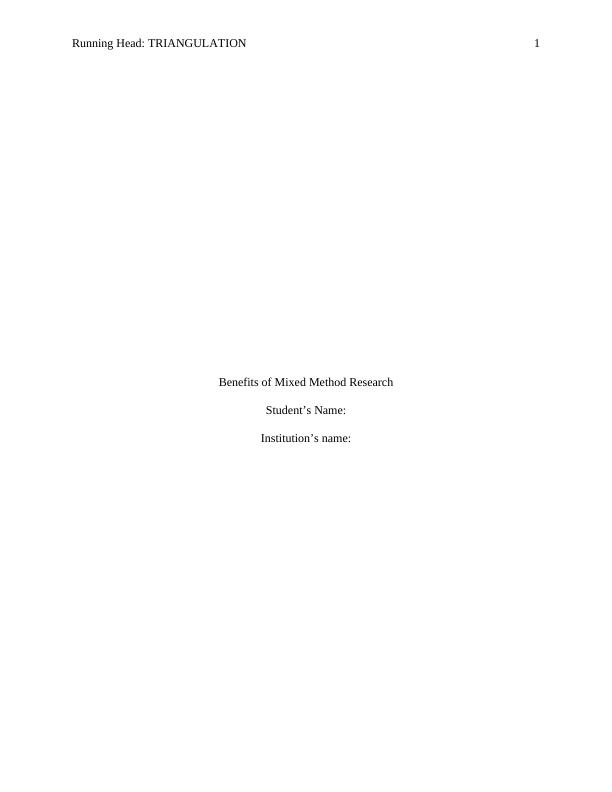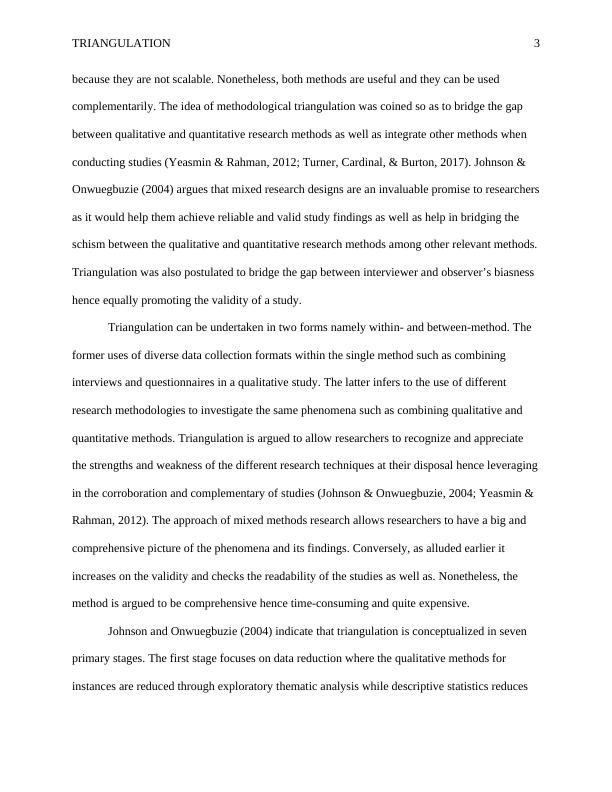Benefits of Mixed Method Research
11 Pages2863 Words427 Views
Added on 2023-05-30
About This Document
This paper discusses the benefits of using triangulation methods in studies. Triangulation is the simultaneous deployment of at least two research methods when conducting a study. The methods are selected based on the convergence, corroboration, and complementarity of the research question when evaluating the same phenomenon. The approach of mixed methods research allows researchers to have a big and comprehensive picture of the phenomena and its findings.
Benefits of Mixed Method Research
Added on 2023-05-30
ShareRelated Documents
Running Head: TRIANGULATION 1
Benefits of Mixed Method Research
Student’s Name:
Institution’s name:
Benefits of Mixed Method Research
Student’s Name:
Institution’s name:

TRIANGULATION 2
Introduction
Research is undertaken to understand and examine some concepts, phenomena or
hypothesis based on the interests of the researcher. The reliability, validity, and quality of
research significantly depend on the reliability of the study design and the approaches used for
the collection of data (Yeasmin & Rahman, 2012). According to Turner, Cardinal, and Burton
(2015), more often than not, most research and data collection methods individually prove
inefficient and flawed. However, so as to enhance the trustworthiness and strength of research,
scholars opted to strategically combine at least two research methods hence mixed research
designs were coined based on the idea of methodological triangulation. Johnson and
Onwuegbuzie (2004) defined triangulation as the simultaneous deployment of at least two
research methods when conducting a study. The methods are selected based on the convergence,
corroboration, and complementarity of the research question when evaluating the same
phenomenon. Johnson & Onwuegbuzie (2004) argue that mixed research methods (triangulation)
elevate the cogency and dependability of findings of a investigation as the method promotes
wide-ranging and corroborative integration of but not limited to the qualitative and quantitative
data collection, analysis, and interpretation. Therefore, this paper aims to discuss the benefits of
using triangulation methods in studies.
Overview of Mixed Research Methods
Johnson & Onwuegbuzie (2004) note that for a long time, social and physical researchers
have engaged is enthusiastic debates on the paradigms of qualitative and quantitative research
methodologies. Social scientists argue that social observation and opinions of people should be
perceived as entities just like physical phenomenon are treated by physical scientists. On the
hand, physical scientist rejects the social scientists’ idea of treating social observation as entities
Introduction
Research is undertaken to understand and examine some concepts, phenomena or
hypothesis based on the interests of the researcher. The reliability, validity, and quality of
research significantly depend on the reliability of the study design and the approaches used for
the collection of data (Yeasmin & Rahman, 2012). According to Turner, Cardinal, and Burton
(2015), more often than not, most research and data collection methods individually prove
inefficient and flawed. However, so as to enhance the trustworthiness and strength of research,
scholars opted to strategically combine at least two research methods hence mixed research
designs were coined based on the idea of methodological triangulation. Johnson and
Onwuegbuzie (2004) defined triangulation as the simultaneous deployment of at least two
research methods when conducting a study. The methods are selected based on the convergence,
corroboration, and complementarity of the research question when evaluating the same
phenomenon. Johnson & Onwuegbuzie (2004) argue that mixed research methods (triangulation)
elevate the cogency and dependability of findings of a investigation as the method promotes
wide-ranging and corroborative integration of but not limited to the qualitative and quantitative
data collection, analysis, and interpretation. Therefore, this paper aims to discuss the benefits of
using triangulation methods in studies.
Overview of Mixed Research Methods
Johnson & Onwuegbuzie (2004) note that for a long time, social and physical researchers
have engaged is enthusiastic debates on the paradigms of qualitative and quantitative research
methodologies. Social scientists argue that social observation and opinions of people should be
perceived as entities just like physical phenomenon are treated by physical scientists. On the
hand, physical scientist rejects the social scientists’ idea of treating social observation as entities

TRIANGULATION 3
because they are not scalable. Nonetheless, both methods are useful and they can be used
complementarily. The idea of methodological triangulation was coined so as to bridge the gap
between qualitative and quantitative research methods as well as integrate other methods when
conducting studies (Yeasmin & Rahman, 2012; Turner, Cardinal, & Burton, 2017). Johnson &
Onwuegbuzie (2004) argues that mixed research designs are an invaluable promise to researchers
as it would help them achieve reliable and valid study findings as well as help in bridging the
schism between the qualitative and quantitative research methods among other relevant methods.
Triangulation was also postulated to bridge the gap between interviewer and observer’s biasness
hence equally promoting the validity of a study.
Triangulation can be undertaken in two forms namely within- and between-method. The
former uses of diverse data collection formats within the single method such as combining
interviews and questionnaires in a qualitative study. The latter infers to the use of different
research methodologies to investigate the same phenomena such as combining qualitative and
quantitative methods. Triangulation is argued to allow researchers to recognize and appreciate
the strengths and weakness of the different research techniques at their disposal hence leveraging
in the corroboration and complementary of studies (Johnson & Onwuegbuzie, 2004; Yeasmin &
Rahman, 2012). The approach of mixed methods research allows researchers to have a big and
comprehensive picture of the phenomena and its findings. Conversely, as alluded earlier it
increases on the validity and checks the readability of the studies as well as. Nonetheless, the
method is argued to be comprehensive hence time-consuming and quite expensive.
Johnson and Onwuegbuzie (2004) indicate that triangulation is conceptualized in seven
primary stages. The first stage focuses on data reduction where the qualitative methods for
instances are reduced through exploratory thematic analysis while descriptive statistics reduces
because they are not scalable. Nonetheless, both methods are useful and they can be used
complementarily. The idea of methodological triangulation was coined so as to bridge the gap
between qualitative and quantitative research methods as well as integrate other methods when
conducting studies (Yeasmin & Rahman, 2012; Turner, Cardinal, & Burton, 2017). Johnson &
Onwuegbuzie (2004) argues that mixed research designs are an invaluable promise to researchers
as it would help them achieve reliable and valid study findings as well as help in bridging the
schism between the qualitative and quantitative research methods among other relevant methods.
Triangulation was also postulated to bridge the gap between interviewer and observer’s biasness
hence equally promoting the validity of a study.
Triangulation can be undertaken in two forms namely within- and between-method. The
former uses of diverse data collection formats within the single method such as combining
interviews and questionnaires in a qualitative study. The latter infers to the use of different
research methodologies to investigate the same phenomena such as combining qualitative and
quantitative methods. Triangulation is argued to allow researchers to recognize and appreciate
the strengths and weakness of the different research techniques at their disposal hence leveraging
in the corroboration and complementary of studies (Johnson & Onwuegbuzie, 2004; Yeasmin &
Rahman, 2012). The approach of mixed methods research allows researchers to have a big and
comprehensive picture of the phenomena and its findings. Conversely, as alluded earlier it
increases on the validity and checks the readability of the studies as well as. Nonetheless, the
method is argued to be comprehensive hence time-consuming and quite expensive.
Johnson and Onwuegbuzie (2004) indicate that triangulation is conceptualized in seven
primary stages. The first stage focuses on data reduction where the qualitative methods for
instances are reduced through exploratory thematic analysis while descriptive statistics reduces

TRIANGULATION 4
the quantitative data. The second phase is data display which infers to pictorial description data
using but not limited to graphs, tables, charts, lists, and matrices. Thirdly, data transformation
stage allows conversion of qualitative data into narrative data (qualitized) or numerical codes
that can be qualitatively scrutinized or statistically quantized (Johnson & Onwuegbuzie, 2004).
Data correlation as the fourth step encompass correlating of either qualitized data and
quantitative data or quantized data with qualitative data. The fifth phase is data consolidation
which involves combining and consolidating qualitative and quantitative statistics to either create
fused or new datasets or variables. Data comparison which is the second last stage, it involves
comparing of the qualitatively and quantitively analyzed data while in the last stage (data
integration) the analyzed data is interpreted either separately or converged from which discussion
and conclusions are drawn. An additional step referred as legitimation is often undertaken to
assess the validity and trustworthiness of both the methods used in the study and their subsequent
interpretations and conclusions.
Empirical Benefits and Challenges in Triangulation
According to De Lisle (2011), there has been an increasing interest in the deployment of
mixed research methodologies in research as well as finding the best ways and alternatives to
systematically integrate qualitative and quantitative methods. Several studies have investigated
the strengths and weaknesses of triangulation while many others have employed the techniques
in investigating several phenomena. For instance, Almalki (2016), Dos Santos et al. (2017) and
Perone and Tucker (2003) evaluated the benefits and challenges integrating qualitative and
quantitative data in mixed research methodlogy in while Ammenwerth, Iller, and Mansmann
(2003) investigated whether triangulation can benefit evaluation studies. Dang’s (2015) study on
the perception of educational stakeholders in vocational training and education in Vietnam used
the quantitative data. The second phase is data display which infers to pictorial description data
using but not limited to graphs, tables, charts, lists, and matrices. Thirdly, data transformation
stage allows conversion of qualitative data into narrative data (qualitized) or numerical codes
that can be qualitatively scrutinized or statistically quantized (Johnson & Onwuegbuzie, 2004).
Data correlation as the fourth step encompass correlating of either qualitized data and
quantitative data or quantized data with qualitative data. The fifth phase is data consolidation
which involves combining and consolidating qualitative and quantitative statistics to either create
fused or new datasets or variables. Data comparison which is the second last stage, it involves
comparing of the qualitatively and quantitively analyzed data while in the last stage (data
integration) the analyzed data is interpreted either separately or converged from which discussion
and conclusions are drawn. An additional step referred as legitimation is often undertaken to
assess the validity and trustworthiness of both the methods used in the study and their subsequent
interpretations and conclusions.
Empirical Benefits and Challenges in Triangulation
According to De Lisle (2011), there has been an increasing interest in the deployment of
mixed research methodologies in research as well as finding the best ways and alternatives to
systematically integrate qualitative and quantitative methods. Several studies have investigated
the strengths and weaknesses of triangulation while many others have employed the techniques
in investigating several phenomena. For instance, Almalki (2016), Dos Santos et al. (2017) and
Perone and Tucker (2003) evaluated the benefits and challenges integrating qualitative and
quantitative data in mixed research methodlogy in while Ammenwerth, Iller, and Mansmann
(2003) investigated whether triangulation can benefit evaluation studies. Dang’s (2015) study on
the perception of educational stakeholders in vocational training and education in Vietnam used

End of preview
Want to access all the pages? Upload your documents or become a member.
Related Documents
Defining triangulation and outline its importancelg...
|4
|455
|53
Defining triangulation and outline its importancelg...
|4
|460
|49
(PDF) Management Research Assignmentlg...
|16
|3364
|84
Triangulation Protocol and Methods PDFlg...
|16
|3364
|328
